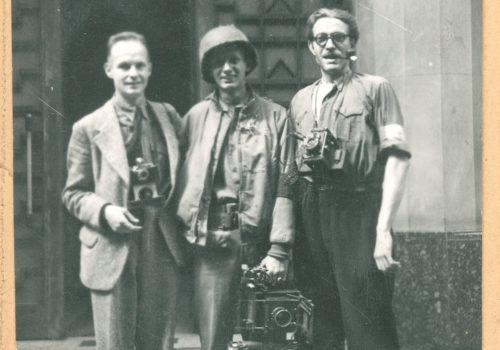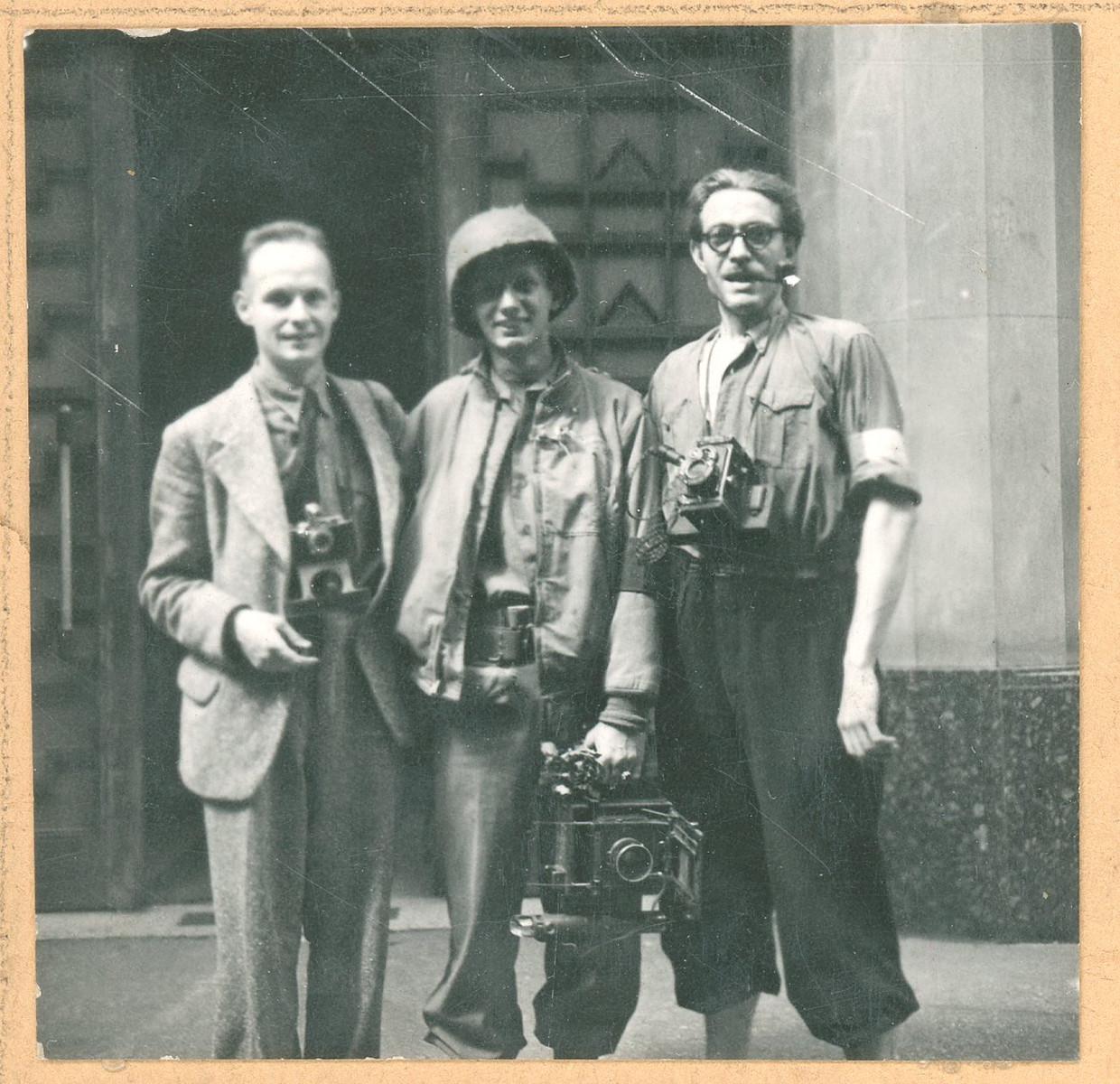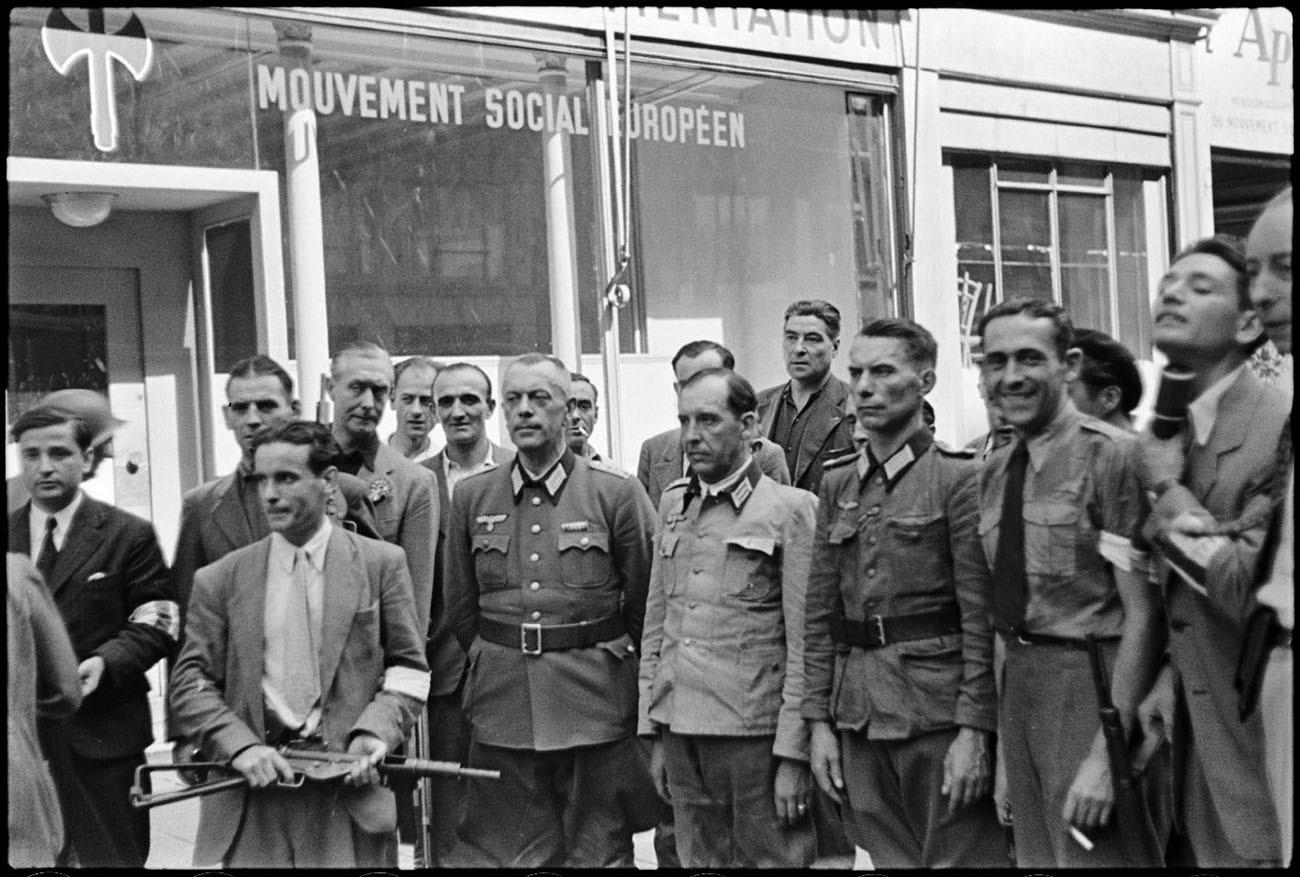The wonders of the Photography and Heritage Media Library, of the Cartier-Bresson Foundation
The treasures of the Casagrande collection and the little joys of research
Marcel Arthaud/Henri Cartier-Bresson/Roger Parry
When writing Photo Agencies A French History, which I did over several years, I was looking for unpublished documents to illustrate the work. With 650 pages of text, we had to forget about images except for the cover. However, I had several hitherto unseen and interesting documents. Jean-Jaques Naudet suggested that I share some of them with the readers of his site.
My friend Bernard Lebrun gave me some nuggets about the liberation of Paris. I only had the photographs and no information about them. Bernard disappeared too soon, how could we find their author?
The first photograph shows three photographers: Henri Cartier-Bresson, a war correspondent, and Henri Membré with his FFI armband (document no. 1). Membré, independent photographer, active during the Occupation, structured and coordinated as best he could the reportages of around thirty photographers to cover the insurrection in the different districts of Paris. His ambition was to create a new agency, Photo Presse Libération, and thus turn the page on four years of occupation. Accompanied by FFI, he requisitioned photographers from agencies active since June 1940. The shots were then taken by the Photo Presse Libération pool, photographers from Agence France Presse, The War Picture Pool, independent photographers and amateurs. After the Liberation, Membré set up the AFP photographic service and imposed his photographers. He took over as technical director of the service, with Roger Parry as deputy.
Document No. 1, Henri Cartier-Bresson, a war correspondent, Henri Membré, Paris August 1944. © Estate Marcel Arthaud, Nicéphore Niépce museum, City of Chalon-sur-Saône.
I was looking for other photographs that would allow me to identify the first one. Thinking that it could be from Roger Parry, a close friend of Membré, I did a search on the website of the Heritage and Photography media library which keeps the collection donated by his widow Madeleine Parry in 1993. I found three inverted negatives where HCB figured.
The director of the MPP, Gilles Désiré dit Gosset, authorized me to publish the documents free of charge.
The first negative presents the same three, in the same place as on document no. 1, photographing themselves under the amused gaze of onlookers (document no. 2). Roger Parry could therefore be the photographer of document n°1. But photograph no. 1 does not appear in the Parry collection.
Document No. 2, the caption states: “A photographer photographs a soldier himself equipped with a camera. » Henri Cartier-Bresson from behind, a war correspondent, Henri Membré, Paris August 1944, © Donation Roger Parry, Ministry of Culture (France), Media Library of Heritage and Photography, RMN-GP broadcast.
Finally, to identify document no. 1 communicated by Bernard Lebrun, it was his colleague and friend Michel Lefebvre who put me on the trail of the Casagrande Collection. The collector told me that on the back of the photograph appeared the name of the photographer: Marcel Arthaud. A contact sheet on which the Arthaud stamp is affixed confirmed this. I had gone the wrong way with Parry. It was Arthaud, whose collection is kept at the Nicéphore Niépce museum, in Chalon-sur-Saône. The director, Sylvain Besson and the rights holders authorised me to publish the document free of charge.
A second negative by Roger Parry where we recognize Cartier-Bresson from behind, perfectly identifiable, always wearing the same suit and his leather case slung over his shoulder, aroused my curiosity (document no. 3). Looking at them, he passes a group of German officers and soldiers who have just surrendered. One of them, in the back, raises his hands in the air. Did Cartier-Bresson take the photograph? Obviously he doesn’t seem interested. As for Parry, he spotted HCB and this is undoubtedly the reason for him shooting.
Document No. 3, the caption states: “August 26, 1944. Liberation parade: German prisoners and FFI”.
Henri Cartier-Bresson passes in front of surrendering Germans, Paris August 1944, © Donation Roger Parry, Ministry of Culture (France), Media Library of Heritage and Photography, RMN-GP broadcast.
I made an appointment with Aude Raimbault in charge of the collections at the Cartier-Bresson Foundation. As always, a great professional, she had prepared the contact sheets for the Liberation of Paris. I looked at them all once, then examined them more carefully one by one. Two sequences caught my attention. On plate no. 0125, six photographs from numbers 22 to 27 show soldiers and officers, arms in the air. They leave a building in small groups, based on contacts. On No. 22, selected by Cartier-Bresson, a soldier clearly stands out from the cohort, but none resembles the Germans on document No. 3. However, the elements of the building, particularly the arrangement of the windows , recall those in Arthaud’s photograph, but this index is insufficient. Men are all different.
It is two contacts n° 20 and 21 on plate n° 0127 that give me the answer that strip is at the end of the plate picture number 19 is taken in a different place than that of number 20. On this last one (document n° 4) selected by the author with a red pencil mark there are soldiers and officers grouped in the same way as in document n° 3 the men are are different except two, the german officer faced on and the FFI with the black tie cigarette in hand. The important element is the inscription on the window pane « European Social Movement» created in 1940 by Pierre Constantini cofounder with Jacques Doriot of the french legion against bolshevism several nazis had to take care of the functionning of the organisation. Aude Raimbault also allowed me to use the document 4 free of charge.
Document No. 4, scan taken from contact sheet No. 127, Libération de Paris. © Henri Cartier-Bresson Foundation / Magnum Photos
Cartier Bresson therefore took the photograph well. He even dedicated eight shots to this sequence. In Arthaud’s photograph, is he arriving or leaving? Has he already operated or not? We do not know. The images must retain a little of their mystery.
On the other hand, on the HCB contact sheets, there is no trace of the photograph in which he shoots at the same time as Membré and the American war correspondent (document no. 2). Was the negative lost or was Cartier-Bresson faking it? Film was rare, was the picture worth it?
Document No. 5, the caption states: “Men and women seated at table, celebrate the victory”.
At the Membré PC, on the left, during a lunch at 100 rue Réaumur where the Committee for the Liberation of Photographic Reporters is based. In the center, probably the press correspondent, Cartier-Bresson in the background. © Donation Roger Parry, Ministry of Culture (France), Heritage and Photography Media Library, RMN-GP broadcast.
From the press correspondent, probably American, (documents no. 1 and no. 2) I still know nothing. On contact sheet no. 125 of Cartier Bresson, there is a contact where there is a correspondent, with the same camera, posing in a room in front of a drawing of Hitler, but is it the same? hard to say. As on Roger Parry’s negative (document no. 5), the character in the center resembles the one photographed by HCB in front of a portrait of Hitler.
If you recognize the correspondent….
We don’t stop research, we suspend it.
Françoise Denoyelle





















